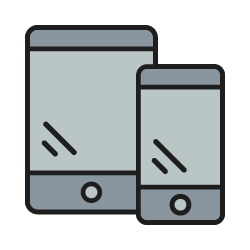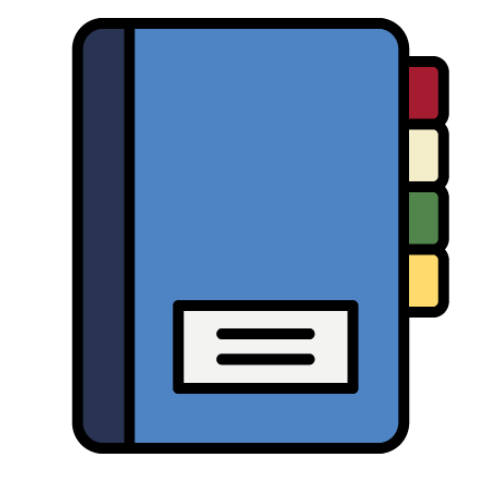Students with sensory disabilities take part in all Harvard courses and programs. This includes blind, visually impaired, deaf, and hard-of-hearing students who all have different lived experiences and accessibility needs.
Students with sensory disabilities develop their own personal methods for navigating academic work and environments, and it’s important that they are always involved in the accommodation process because they understand their needs best.
Supporting Blind/Visually Impaired Students
- Common academic accommodations
- Some experiences of Blind/Visually Impaired students
- Working with the Assistive Technology Center (ATC)
- Tips for making your course accessible for Blind/Visually Impaired students
Common Academic Accommodations for Blind and Visually Impaired Students

Accommodated testing for in-class and online exams and quizzes

Alternate format texts and handouts, including audio, electronic, and braille formats

Using note-taking and/or audio recording technology during class lectures

Permission to use technology such as laptops, tablets, or assistive technology in the classroom

Flexible travel times between classes for navigational purposes

Lab assistants to help with visual elements of lab environments

Lecture content provided in advance of class

Preferential seating
Blind and visually impaired students may:
- Experience vision loss on a spectrum that ranges from significant usable vision to total blindness.
- Have extensive training with orientation and mobility skills or be developing them
- Experience various impacts to visual functioning that may cause eye strain, difficulty perceiving details or reading small font, light sensitivity, and color deficiency/blindness
- Primarily use braille, digital formats, screen readers, or text/screen magnifiers
- Navigate using white canes, service animals, and/or assistive technology
- Wear sunglasses across environments for safety or to protect from light sensitivity.
- Present as “visibly” blind or show no observable evidence of a visual impairment
- Use braille, screen reading technology, and/or magnification to access computers, tablets, smartphones, or other technology for their academic work and follow along with lecture slides and materials using their own devices in real time
Working with the Assistive Technology Center (ATC)
Through the accommodation process, blind and visually impaired students are typically referred to the Assistive Technology Center, a partner office to DAO that provides academic materials in accessible formats.
- The ATC will meet with students once they have enrolled in courses to review syllabi and identify what materials or assignments need to be converted and or modified for accessibility.
- The student, their DAO advisor and their ATC liaison meet with course staff at the start of the semester to review approved accommodations and course requirements and determine a plan for collaboration.
Advance planning and early delivery of course materials to the ATC is critical throughout the semester.
- The ATC requires at least 5 business days to deliver text in alternative formats, and braille production can take significantly longer.
- Students with this accommodation should receive written materials at the same time as their peers.
Tips for making your course accessible for blind and visually impaired students
Before your course begins
- Consider the structure of your course and what elements are highly visual. Are there modifications that could be made to make these elements more accessible for blind and visually impaired students?
- Select your required materials before the registration period and make that information available as early as possible when working with the ATC.
- Consult with DAO in advance to talk through any aspects of your course that may be inaccessible for a student with vision impairment.
Accessible Practices
 DO
DO
Ask the student directly how they need to access the classroom, exams, course materials, or assignments.
Read aloud anything that is written on the board, lecture slides, or other visual aids when lecturing.
Clearly describe images used during lecture and write alternative text for images on slides.
Show films with audio description turned on. Contact DAO in advance for assistance.
Provide lecture slides in advance of class.
Provide advance notice about tests and quizzes.
Announce who you are by name when you’re speaking in a group setting and ask other speakers to as well. (Example: Tom speaking, or This is Tom)
Maintain a normal speaking voice and face-to-face contact if eye contact is not possible.
DON’T
Leave students out of conversations about their access needs.
Spontaneously call on students to read aloud from an inaccessible format (such as words on a white board).
Use vague language like “this” and “that” when referring to an image.
Show films without audio description or cancel the use of visual content before consulting with the DAO about options.
Deliver all materials right before they are being used.
Give un-announced pop-quizzes without accessible formats.
Have large group conversations without naming each speaker or have speakers talking over one another.
Raise your voice or direct your attention to someone else when talking to the blind or visually impaired student.
Navigation Assistance
- If a student seems to need assistance, identify yourself and ask if there is anything you can specifically help with.
- If they ask for help navigating an area and you are acting as a guide, let them take your arm just above the elbow and walk in a relaxed manner. Give a verbal warning when you are approaching a step or other obstacle. Do not grab, pull, or push the person along.
- Do not interrupt a student’s cane usage, grab or lead them without their permission, or assume that they need help. When in doubt, simply ask.
- If a student needs frequent/daily assistance navigating within the same space, contact DAO. There may be Orientation and Mobility training that can be provided to better orient the student to this environment.
Environmental Considerations
- If any room changes occur, make sure to verbalize this arrangement. Students may not be able to access a notice written on a whiteboard or taped to a door.
- Inform the student when classroom furniture has been rearranged.
- Consult with the student and DAO is there are any safety, accessibility, or transportation issues involving fieldwork or field trips.
- The DAO can assist with providing accessible furniture, such as tables for monitors or other equipment.
- Classes taught in laboratory settings may require workstation modification. Some students may also require a lab assistant. DAO will reach out to you to help make these arrangements.
Supporting Deaf and Hard-of-Hearing Students
- Common academic accommodations
- Some experiences of Deaf and Hard-of-Hearing students
- Working with Education Support Services (ESS)
- Tips for making your course accessible for Deaf and Hard-of-Hearing students
Common Academic Accommodations for Deaf and Hard-of-Hearing Students

Accommodated testing for in-class and online exams and quizzes

Captioned media

Using note-taking and/or audio recording technology during class lectures

Permission to use technology such as laptops, tablets, or assistive technology in the classroom

Sign language interpreting

Professional real-time captioning in class (either through remote or in-person providers)

Instructor use of microphone in class

Multi-directional microphones in class, or portable microphones to be passed around

Preferential seating
Deaf and hard-of-hearing students may:
- Utilize a combination of technologies and communication styles, including reading lips, using hearing aids and/or cochlear implants, reading captioned text, or communicating using sign language
- Control hearing aids through their smartphones or use their smartphones as microphones
- Use auto-captioning tools, professional captioning or ASL interpreting services in the classroom
Working with Education Support Services (ESS)
Through the accommodation process, students are sometimes referred to Education Support Services, a partner office to DAO that helps configure the accessibility of media and technology in classrooms. DAO and a representative from ESS may tour classrooms with the student to assess how the student’s assistive listening technology interacts with the audio system in the classroom.
Tips for making your course accessible for deaf and hard-of-hearing students
Before your course begins:
- Consider the structure of your course and what elements are primarily auditory. Establish norms in your teaching practices that require all speakers to use microphones whenever possible
- Select or create video content that includes captions. Set Zoom meetings to always have auto-captions enabled. (Note: computer generated captions are typically not 100% accurate, and professional captioning services may be necessary for access.)
- Consult with DAO in advance to talk through any aspects of your course that may be inaccessible for a student with hearing loss
Accessible Practices
 DO
DO
Ask the student directly how they need to access class lecture, exams, course materials, or assignments.
Repeat back on a microphone any student discussion or questions that are not amplified. Please repeat words as precisely as possible (do not paraphrase).
Use a microphone whenever possible and speak at a clear, moderate rate without covering your mouth.
Show films with captions turned on. Contact DAO in advance if you need assistance.
Write or draw on the board, and then face the class to speak.
Look directly at the student when speaking, even if an interpreter or captioner is present.
Provide new vocabulary in advance when possible, and work with the DAO to provide access to course materials to the interpreters and captioners.
DON’T
Leave students out of conversations about their access needs.
Allow speakers to state that they will just talk louder instead of using a microphone.
Raise your voice significantly, yell, or whisper.
Show films without captions or cancel the use of video content before consulting with the DAO about options.
Speak while writing on the board with your back turned to the class.
Speak to the interpreter or captioner instead of to the student.
Introduce complex terminology without students and service providers having access to the terms for reference.
Tips for working with sign language interpreters
- Speak directly to the student and not to their sign language interpreter. The interpreter is not part of the conversation and is not permitted by professional ethics to voice personal opinions or enter the conversation. The interpreter will relay everything that is spoken to the student, so there is no need to ask them to do so.
- When signing, the interpreter is keeping pace at a few words or phrases behind the speaker. Give the interpreter time to finish before you ask questions so that the student can join in on the discussion.
- Provide good lighting for the interpreter when they are in-person. Any time a presentation requires darkening the room to view slides or films, supplementary lighting is necessary so that the student can see the interpreter.
- Ask that only one person speaks at a time during group discussions. It is difficult for an interpreter to follow several speakers at once. Allow for a brief pause between speakers.
- Speak clearly and in a normal tone when using an interpreter. They may ask you to repeat a word or sentence for clarification.
